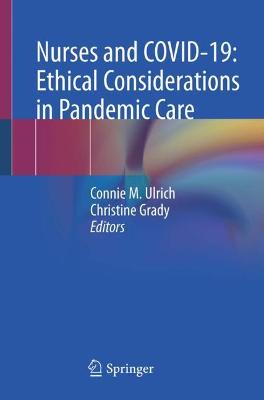(To see other currencies, click on price)
MORE ABOUT THIS BOOK
Main description:
This book addresses the many ethical issues and extraordinary risks that nurses and others are facing during the COVID-19 pandemic, which creates physical, emotional, and economic burdens, affecting nurses' overall health and well-being. Nurses are essential front-line clinicians across all health care settings and in every nation. The COVID-19 pandemic caused by the novel SARs-CoV-2 virus has affected children, adults, and communities within and across all societies. Nurses, too, have contracted the virus and died from the disease. They have also seen their colleagues, family members, and friends hospitalized or in intensive care units struggling to survive. Nursing's professionalism and disciplinary resolve to care for patients and families amidst confusion, misinformation, and shifting guidelines has been called "heroic" by the public.
How much risk should nurses be expected to accept during a pandemic? How do nurses help patients and families find comfort and dignity at the end-of-life? How do we help nurses who are suffering from moral distress and mental health concerns from what they have seen, been asked to do, or are unable to provide? And, how does society move forward from a pandemic that has challenged our basic ethical principles of justice and what is "fair, good and right" in caring for those who need care, including the most vulnerable and nurses themselves? This book addresses these and other ethical concerns that nurses are facing in their day-to-day clinical practice; experiences shared with patients, families, and colleagues. Although this book was written while the pandemic was still raging across the United States and globally, the events needed to be told as they were unfolding.
This book helps us to learn from both the successes and failures that are affecting so many across the globe, including those on whom the public relies on to provide quality, compassionate, and expert care when they are sick: nurses.
Contents:
Chapter 1. IntroductionChristine Grady and Connie Ulrich
Chapter 2. Understanding Acceptable Risks in Healthcare? [Occupational risks/limits/PPE/obligations]a. This chapter will focus on how we define an "acceptable risk" in healthcare. We will discuss the many risks that nurses encounter in their day-to-day patient care activities during COVID-19 both within hospital systems and other types of care facilities, including working without protective equipment and the general risks to patients and families. (adding statistics on risks for CPR, risks to ICU providers and others; risks with use of PPEChristine Grady and Connie Ulrich
Chapter 3. Finding Compassion: Helping Patients Die and Sometimes Alone a. This chapter will discuss the role of nurses and others (palliative care) in helping patients die, often alone, within intensive care environments or other settings. We will share some of the innovative ways in which nurses and others met their foundational moral obligations to patients at the end-of-life, honoring the dignity of patients, and helping families through this stressful time. Christine Grady and Connie Ulrich
Chapter 4. Preparing to Make Difficult Choices: Triage Decision and Crisis Standards of Care a. This chapter will speak to the different models of triage decision-making and the ethics of priority setting and allocation of scarce resources.Christine Mitchell
Chapter 5. The Emotional and Moral Remnants of COVID-19: Burnout, Moral Distress, and Mental Health Concerns a. The pandemic has focused our attention to the mental health concerns of front-line nurses, including their moral distress, burnout, depression, and emotional scars from a sense of exhaustion, tragic choices, and overwhelming circumstances.
Christine Grady and Connie Ulrich
Chapter 6. Unintended Consequences: Lack of Essential and Nonessential Patient Care, Furloughs of HCP, and Institutional Financial Lossesa. The COVID-19 pandemic has given rise to unintended consequences of what is considered essential and nonessential patient care. Patients, for example, were delayed in seeking surgical services or other types of specialty care (e.g., cancer care). With the focus on COVID-19 patients, nurses have also been furloughed, affecting their economic livelihood. This chapter will highlight and discuss these concerns.
Dr. Peter Buerhaus and colleagues
Chapter 7. Lingering and Glaring Health Disparities amidst COVID-19 a. The COVID-19 related illnesses and deaths in minority and socially disadvantaged communities warrants our attention. This chapter will discuss these inequities and the social justice implications for quality and equitable care outcomes. Dr. Nneka Sederstrom
Chapter 8. School nurses/pediatric concernsAuthor TBC
Chapter 9. Global Health Ethics: Nursing Voices from China and Brazil a. This chapter will highlight the voices of nurses in two of the countries most significantly affected by COVID-19: China and Brazil. It is important to learn from both countries and to discuss the similarities and differences in caring for their populations and the role of nurses in these countries. Drs. Ulrich and Grady will provide pre and post comment to the essays
Chapter 10. Moving Forward: What Have We Learned? Where do we go from here? [Conclusion] (Opportunities to move forward). Small "words of wisdom" from several nurse leaders (President of ICN, President of Sigma Theta Tau International, Liz Stokes-ANA and others). We ask several national and international nurse leaders to provide us with "words of wisdom" to help us move forward from the pandemic. Drs. Ulrich and Grady will provide commentary on these segments and conclude with their own "words of wisdom" to
For each of the chapters, we will ask the authors to include a section on how the lessons learned from COVID-19 might have emerged from prior pandemics and might apply to future pandemics
PRODUCT DETAILS
Publisher: Springer (Springer Nature Switzerland AG)
Publication date: April, 2022
Pages: None
Weight: 318g
Availability: Available
Subcategories: Epidemiology, Nursing

